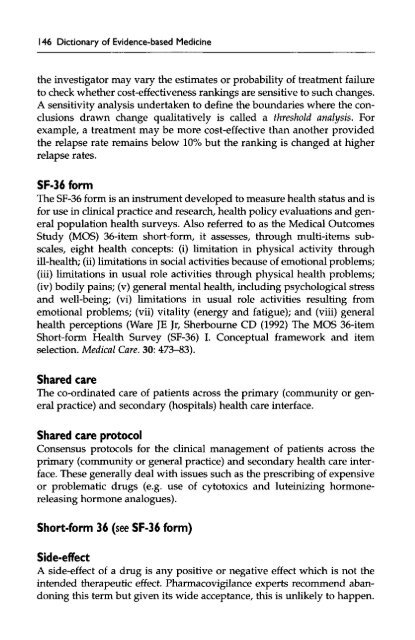Dictionary of Evidence-based Medicine.pdf
Dictionary of Evidence-based Medicine.pdf
Dictionary of Evidence-based Medicine.pdf
Create successful ePaper yourself
Turn your PDF publications into a flip-book with our unique Google optimized e-Paper software.
146 <strong>Dictionary</strong> <strong>of</strong> <strong>Evidence</strong>-<strong>based</strong> <strong>Medicine</strong><br />
the investigator may vary the estimates or probability <strong>of</strong> treatment failure<br />
to check whether cost-effectiveness rankings are sensitive to such changes.<br />
A sensitivity analysis undertaken to define the boundaries where the conclusions<br />
drawn change qualitatively is called a threshold analysis. For<br />
example, a treatment may be more cost-effective than another provided<br />
the relapse rate remains below 10% but the ranking is changed at higher<br />
relapse rates.<br />
SF-36 form<br />
The SF-36 form is an instrument developed to measure health status and is<br />
for use in clinical practice and research, health policy evaluations and general<br />
population health surveys. Also referred to as the Medical Outcomes<br />
Study (MOS) 36-item short-form, it assesses, through multi-items subscales,<br />
eight health concepts: (i) limitation in physical activity through<br />
ill-health; (ii) limitations in social activities because <strong>of</strong> emotional problems;<br />
(iii) limitations in usual role activities through physical health problems;<br />
(iv) bodily pains; (v) general mental health, including psychological stress<br />
and well-being; (vi) limitations in usual role activities resulting from<br />
emotional problems; (vii) vitality (energy and fatigue); and (viii) general<br />
health perceptions (Ware JE Jr, Sherbourne CD (1992) The MOS 36-item<br />
Short-form Health Survey (SF-36) I. Conceptual framework and item<br />
selection. Medical Care. 30: 473-83).<br />
Shared care<br />
The co-ordinated care <strong>of</strong> patients across the primary (community or general<br />
practice) and secondary (hospitals) health care interface.<br />
Shared care protocol<br />
Consensus protocols for the clinical management <strong>of</strong> patients across the<br />
primary (community or general practice) and secondary health care interface.<br />
These generally deal with issues such as the prescribing <strong>of</strong> expensive<br />
or problematic drugs (e.g. use <strong>of</strong> cytotoxics and luteinizing hormonereleasing<br />
hormone analogues).<br />
Short-form 36 (see SF-36 form)<br />
Side-effect<br />
A side-effect <strong>of</strong> a drug is any positive or negative effect which is not the<br />
intended therapeutic effect. Pharmacovigilance experts recommend abandoning<br />
this term but given its wide acceptance, this is unlikely to happen.










